Inside a rabbit fur fashion designer’s 10sqm, solar-powered eco cabin in Central Otago
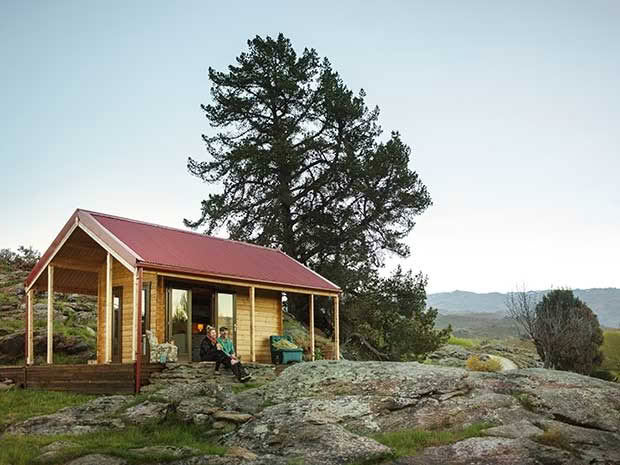
A Dunedin designer’s beautiful bespoke garments incorporate wild pest fur. No wonder Central Otago’s plentiful rabbits steer well clear of Jane Avery’s tiny Earnscleugh holiday cabin.
Words: Lee-Anne Duncan Photos: Rachael McKenna
This story was originally published in the Jan/Feb 2019 issue of NZ Life & Leisure.
It should be prime rabbit country, this hectare of grass and rock with dying, drying gorse, a lone pine self-seeded long ago on a crop of ancient rock and plenty of places to burrow and breed.
“Strangely enough I see hardly any rabbits when I’m here,” says Jane Avery. “I think they know what I do with them.”
Once a television reporter and producer and now the designer behind Dunedin label, Lapin, Jane creates limited-edition, bespoke coats, jackets and accessories featuring Central Otago rabbit fur.
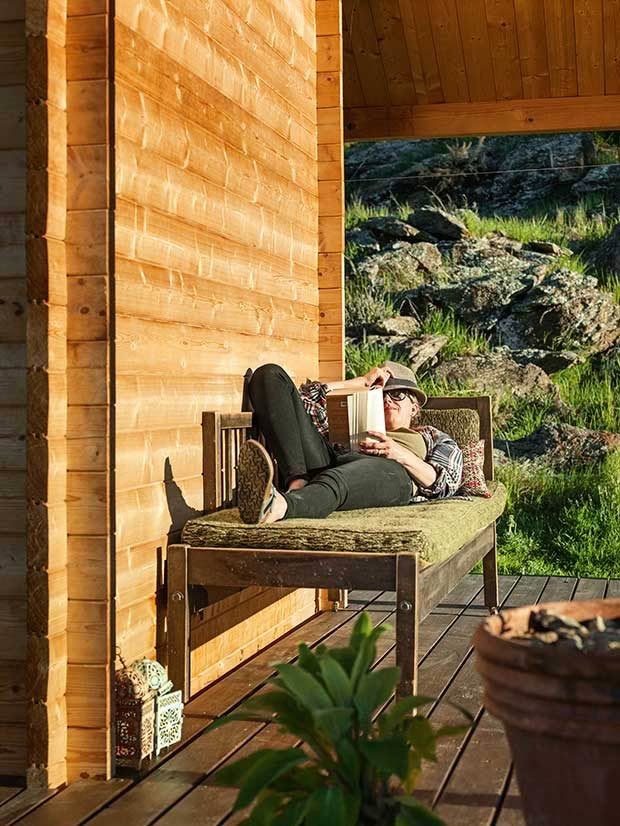
The label, French for rabbit, is all Jane — she’s stitched every stitch. She has been sewing since she was 11, learning from her mother.
“I started sewing in earnest when I had my son, who’s now 18. I’d stopped working as a television reporter so I no longer had a nice clothing allowance.”
When Jane moved to Dunedin from Auckland in 2011 she knew her next move would be a fashion business. But such is the southern climate that palazzo pants and breezy blouses are not practical, while coats are a necessity.
“I’ve always seen a resource in the rabbits and I started thinking, ‘How can I use this fur?’”
Meanwhile, at the cabin she and husband Jeff have built on Earnscleugh Road just out of Alexandra, there’s no place for designer duds, least of all a Lapin “eco-couture” original. Better is her favourite Nitro Circus T-shirt, jeans, tramping boots and a second-hand Workshop wool jumper so Jane can put her hand to whatever’s needed — planting willow trees, rooting out gorse, emptying the composting toilet. Best not to wear one’s best for jobs like those.
“Sometimes it does feel like we’ve taken on a lot, but you do a bit at a time. The paddock management did get to me for a while.”
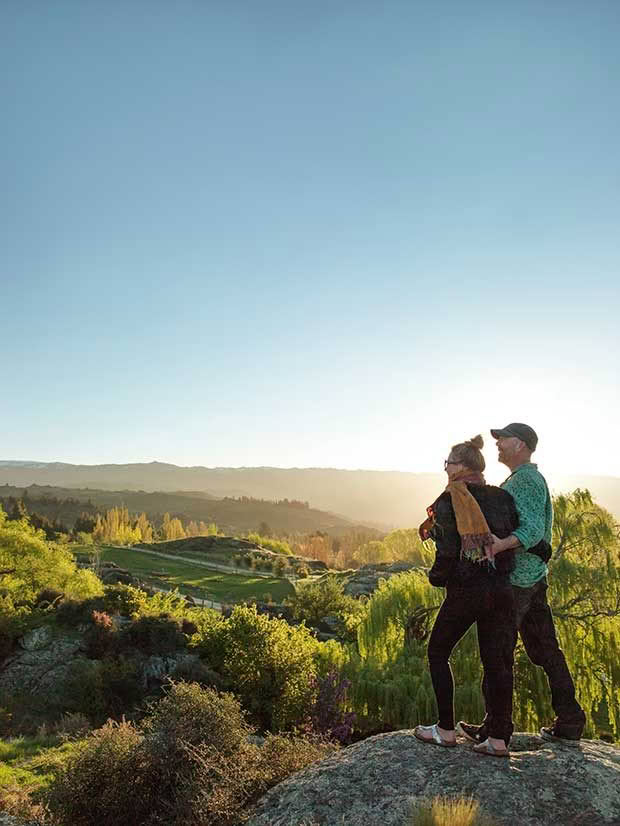
While Jane and Jeff Avery live and work in Dunedin, the fashion designer and television editor take the 2.5-hour drive to their hectare of Central Otago heaven as much as possible. They are planning a bigger home close to the cabin one day — if they can just decide what to build. Whatever it is, it will take in the view that reminds Toronto-born Jeff of Canada.
Jane and Jeff bought their hectare of Central Otago paradise in July 2016 and started building their tiny cabin in May 2017. They had just sold their house in Dunedin and, after missing out at a couple of auctions where Jane feels they should have earned commission for driving the price up, they decided to rent in the city and instead buy “up Central”.
“We drove all around the region. We liked Clyde and Earnscleugh, and then this place came on the market. We came to look and stood here on a bleak, cold, snowy day and decided to buy it,” says Jane.
It’s quite the spot, with terrific views of the Dunstan and Old Man Ranges. For Jeff, raised near Toronto, the area reminds him of home.
“I look across at the snow on the top of the Old Man Range, and it’s calling to me to come back-country skiing. If we planted blueberries and had bears, I’d feel right at home.”
The pair can’t yet decide what shape their future home will take, but they’re having fun imagining. Ideas range from a yurt on top of the rock; a Scandi-style stilted pavilion incorporating the pine tree; or a container house with a Japanese hot tub atop the rock.
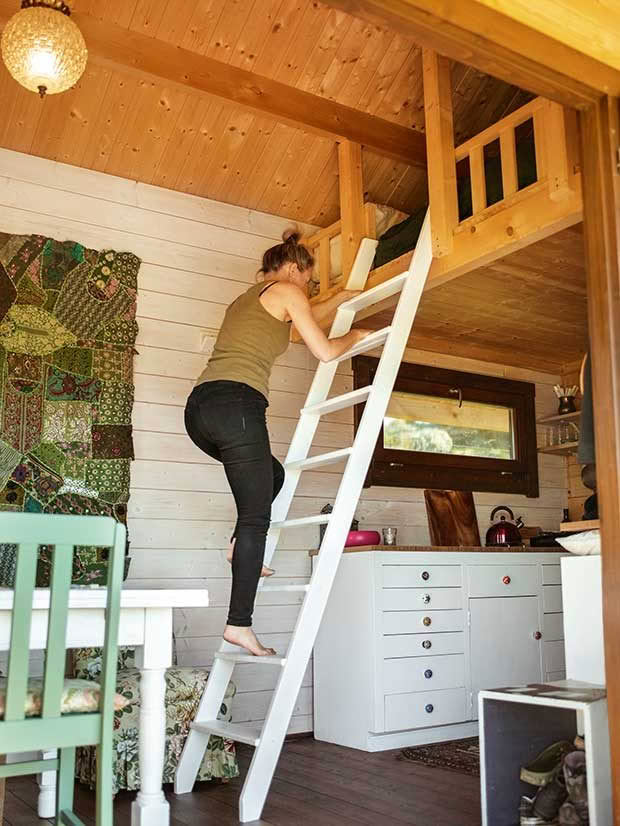
Vertical storage is crucial in a small space — for plates, pots, and even sleeping, as Jane and Jeff sleep in an alcove created by the pitched roof.
They’re now into their second summer with their cabin, taking the time to learn the seasons and how the wind prevails, and to decide whether to plant olives or vines in a sheltered gully over the back.
“It’s an ongoing argument,” says Jeff. “Certainly, our future house will be bigger than our cabin. We’re not tiny-house people.”
“This cabin is about as big as the wardrobe I’d love to have,” says Jane. “Not that we’ll build a house big enough for that. We aim to build something compact, functional and inexpensive, so long as it has a studio for Jeff and a workroom for me. Whatever we do, our vibe is not to have to disturb the land too much — although that pine tree’s probably going to have to come down.”
“I like it,” says Jeff. “I like its Blair Witchy vibe. It provides shade, and it’s a perfect bird tree with tūī and bellbirds and fantails.”
There’s always a lot to talk about when you have a hectare’s worth of lifestyle potential.
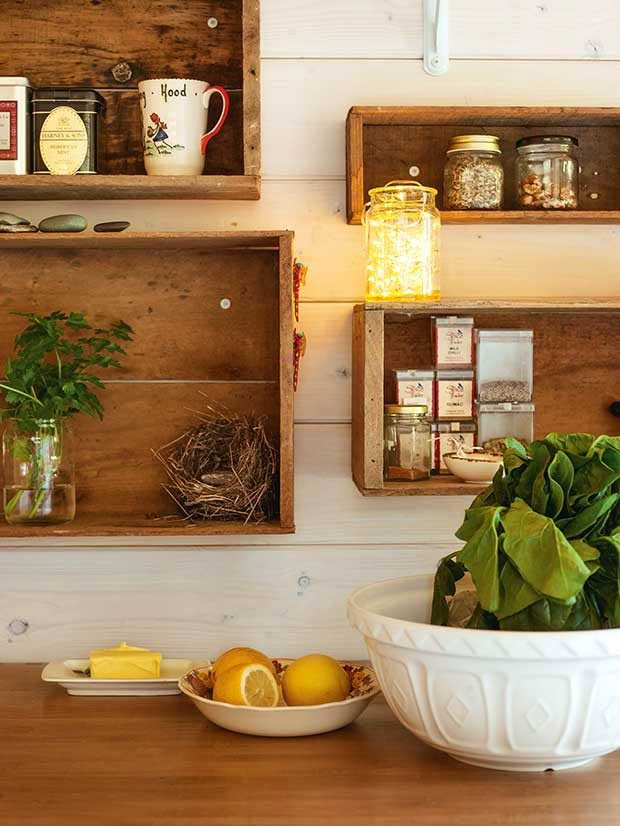
Until they make a permanent move — which may not be too far off now their son Angus is about to start university — they remain renting in Dunedin, where Jane has her Lower Stuart Street workroom, and Jeff is an editor, director and composer for NHNZ (formerly Natural History NZ). The pair met in China in 1999 when Jeff was working in Beijing. Jane stopped off to see a friend on her way to London and met Jeff. She never made it to London. Over the next year the couple made television programmes and corporate videos in China, before moving to Auckland where Jane joined the Holmes show as a reporter.
“Then Peta Mathias walked into our lives,” says Jeff.
For the next 10 years — among other projects — the pair made cooking and travel shows with the popular flame-haired presenter, including documenting her travels to India. It was there Jane got hooked on the potential of vintage saris, particularly in combination with New Zealand rabbit fur.
“I’m now addicted to India. I’ve been three times — once on a buying mission — and I need to feed my addiction again soon.”
That requires days spent in sweltering markets in Jaipur and Mumbai, feeling her way through tonnes of fabric. Vibrancy, texture, and prints are a selling feature of her handmade designs (though she also offers a range of simpler wool coats as “sensible pieces”) for those eager to ditch the ubiquitous black puffer.
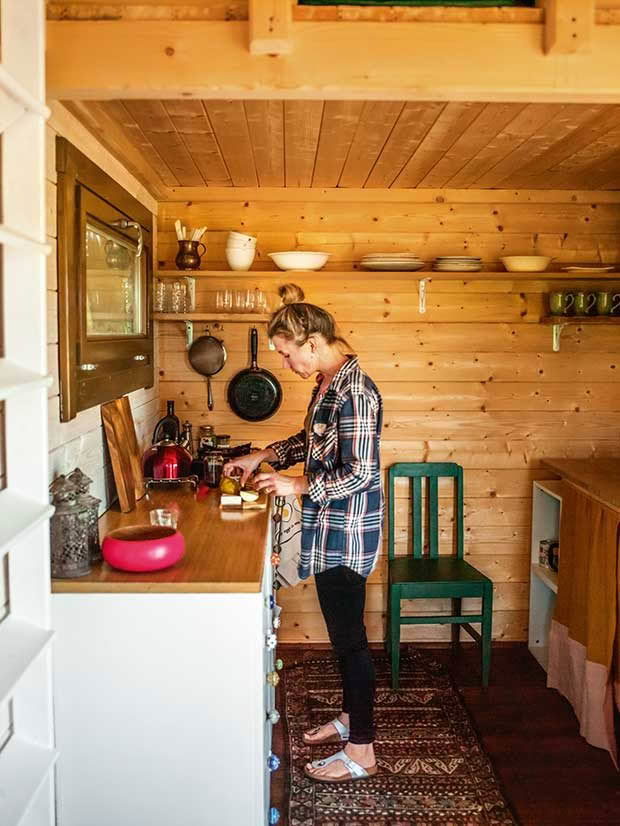
The couple plans to build a kitchen just off the cabin, but for now food is prepped on an old bench donated by a friend’s mother that’s been whitewashed back to life. Jane was delighted to have an excuse to splurge on the colourful handles she’s admired in various gift shops over the years.
All sewers have a fabric stash and Jane’s is a cupboard of carefully folded textiles, including antique Scottish paisleys and Kashmiri embroideries. The best saris hail from northern India and Pakistan as they’re heavier silks, thus lending themselves to being repurposed as winter coats, she says. Many of the designs are geographically significant – the Taliban-ravaged Swat Valley in Peshawar, for example.
“I have a lot of respect and admiration for the craftspeople, and I use the fabrics very carefully. It almost seems criminal to cut them, but I look at a beautiful fabric and think, ‘Those would make great bomber jacket sleeves.’”
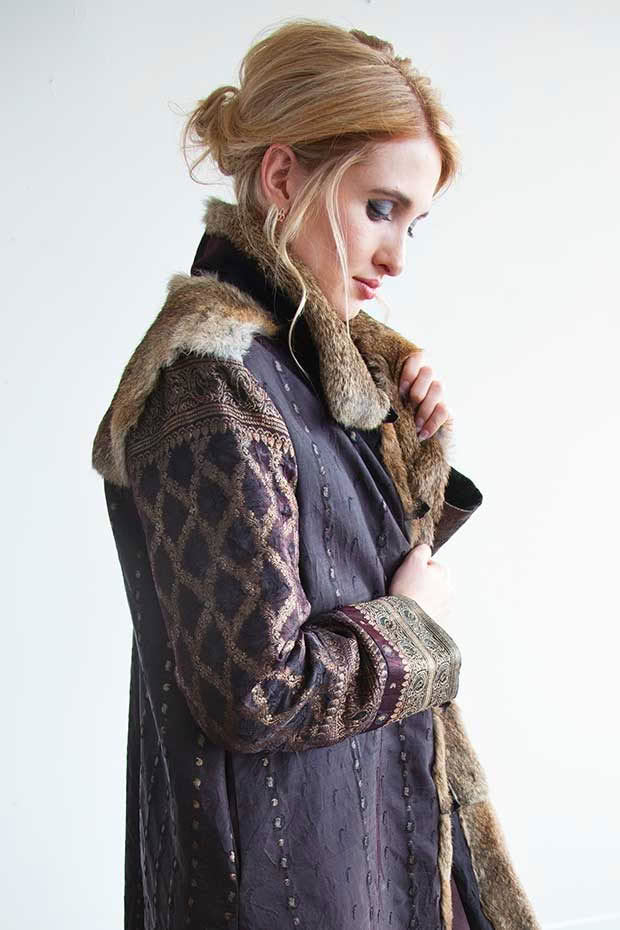
Many of the saris could be 40-years-old and they’re all in excellent nick, barring the odd turmeric accident. Jane will wash the stain, or carefully cut around it, fitting the fabric to her design. She then adds a layer of wool insulation, lines it and pieces it together. As a final touch, she heads down to Mooney’s Furriers to pick up her prepared rabbit skins. Using Mooney’s cupping machine, she invisibly stitches in the collars, yokes or trims to complete her coats.
While the saris catch the eye, the rabbit fur shares equal billing. For Jane, her coats are a complete eco-product using natural or pre-loved fabrics combined with a massively destructive pest. Through the winter, when the rabbit furs are at their most luxurious, her Earnscleugh-based rabbiter Ray Moffat retrieves rabbits he believes will fit Jane’s bill. He carefully skins and bags them, then stores them in his freezer until there’s enough to send to the tannery, Invercargill Animal Tanning Services. Tanned, Jane takes them to Max Wilson at Mooney’s.
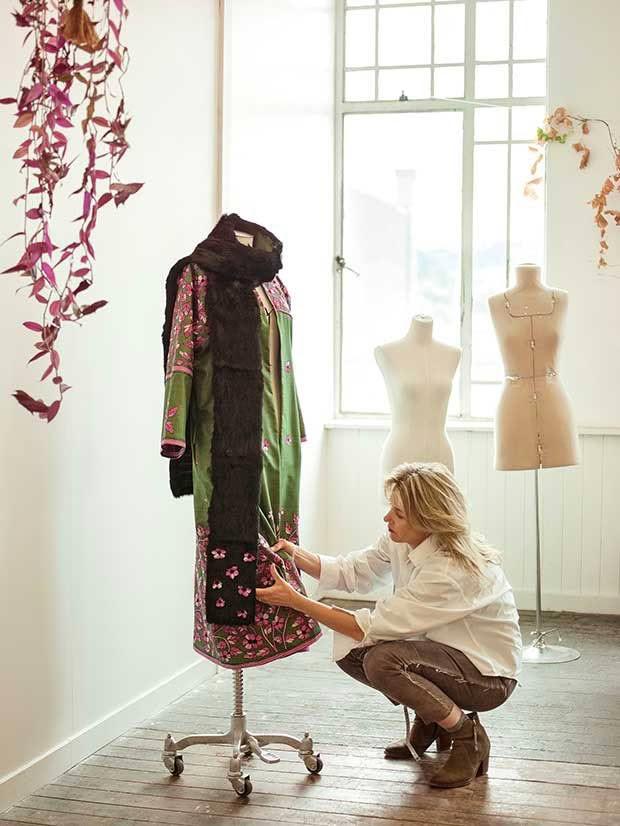
“It’s my major investment for the year,” says Jane. “I pay Ray, then the tannery, then Max, and suddenly I’m up for thousands of dollars. For a bespoke business that’s only three years old, it’s a big scary adventure.”
Add in the good 30 to 50 hours it takes Jane to handmake each garment, and it’s easy to see why a Lapin coat is what’s known in fashion parlance as “an investment piece”.
Jane experiences no disquiet about using the animals in her garments.
“Fake fur is made from petrochemicals so that’s terrible environmentally, and I’ve no intention of using a farmed product. The rabbits get a quick dispatch, and they’re being eradicated anyway for the good of the land so we may as well honour the animal by using as much of it as we can.
“But I do a little internal ritual when I receive a new batch of furs. I have a moment of saying ‘thank you’ to the rabbits. The tragedy of it is not lost on me, but there’s a practicality and realism to using a pest resource. I think most New Zealanders understand that.”
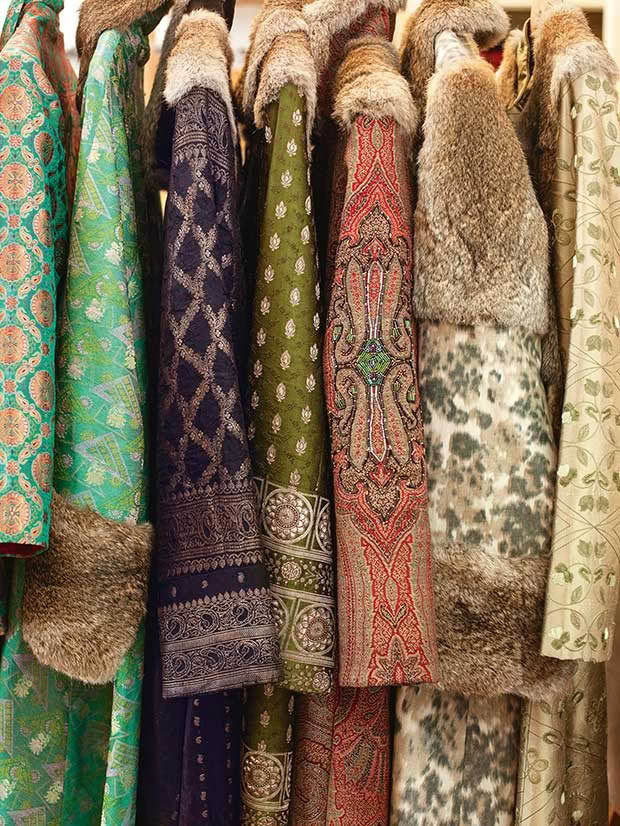
FUR(M) FRIENDS
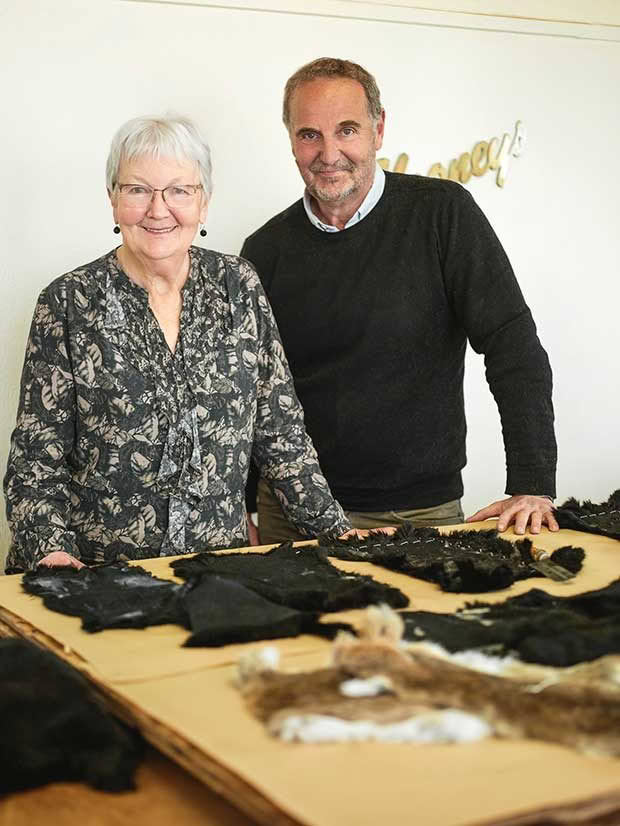
Max Wilson and Heather Kirk.
When Jane Avery decided to start a business using fur, her location couldn’t have been better; turns out she lives in the city with probably New Zealand’s last true furrier. Mooney’s Furriers is a nearly 100-year-old furrier company with the bare minimum of an online presence.
“I found them through an old news story. I didn’t even know if they still existed, but I went to see them and told them I planned to make bespoke coats with rabbit fur,” says Jane.
Mooney’s current owners, furrier Max Wilson and business partner Heather Kirk, were bemused.
“We thought it’d go nowhere and we’d never see her again,” says Heather. But no; back came Jane with her coats and her furs and urged Max — a second-generation furrier from Manchester — to get busy treating them, and to teach her to use the deceptively simple and specialized cupping machine. It quickly became something of a partnership and they’re clearly fond of each other.
“I could not do what I’m doing without them. They’re essential to the Lapin enterprise.”
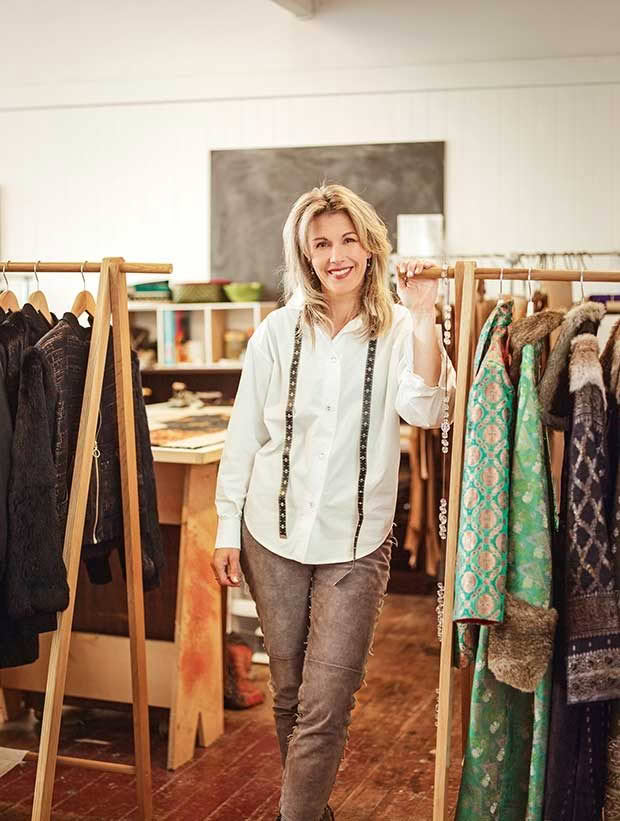
Max started work at Mooney’s back in 1987, while Heather began sewing in 1973, later moving into sales. When the business faced the wall 20 years ago, the pair decided to buy.
“Fur is cyclical so we knew it would come back up again, especially when using a sustainable product like rabbit and possum,” says Heather.
When Jane’s selected skins are tanned and dyed (some black, others are left natural), she sends them to Mooney’s. Max then stretches them, “damages” (meaning to repair damage) any imperfections, bald spots or holes, and cuts them to Jane’s patterns.
“My skins are a wild resource so are imperfect and varied,” says Jane. “Max accepts that — these furs have character.”
When the pieces are ready, Jane visits the Mooney’s workroom with her almost-completed coats and painstakingly sews in the fur.
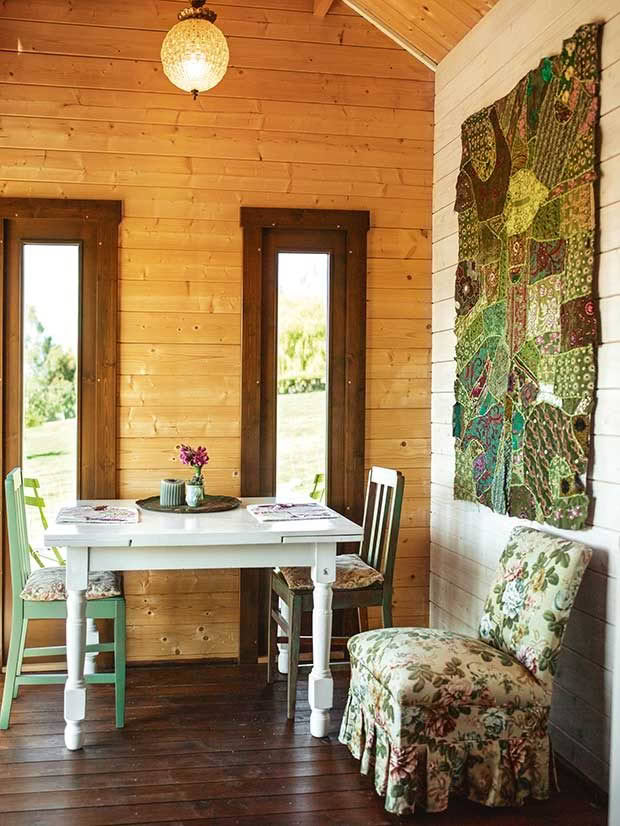
The green wall hanging is from Pakistan, made from remnants of fabric stitched into a panel traditionally used as a bed canopy.
“There’s no seam allowance in the fur so it’s technically tricky to create a clean seam. I’m a self-trained designer so I had to work out my own way of doing it. There’s been trial and error along the way and I’ve learned a lot from Max and Heather,” says Jane.
In the early days Heather helped with construction, but Jane soon took charge of the cupping machine.
“She didn’t even break a needle on her first go,” says Heather. Jane’s broken a few since. “Not too many. I think I’m still in the single digits,” she says.
Jane’s keen to learn more about using fur, and with Max eyeing retirement, she may just have to do that.
CABIN FEVER
Jeff Avery always wanted his own cabin. The Canadian-now-New Zealander was reminded of that recently when an old friend contacted him on Facebook.
“He quoted me saying, ‘Matty, one day, I’m going to build a cabin.’ For me, cabins mean skiing and winter.”
But at only 10 square metres, Jeff and Jane Avery’s Eurowood cabin, imported via Christchurch from the Czech Republic for $30,000, seems more set up for summer than the Central Otago winter. Still, it’s insulated, powered by solar energy, and takes nothing to heat. The cabin’s size means no building consent was necessary, the 33-degree angle of the roof creates a sleeping loft inside, with deep eaves shading an equal amount of outdoor space around the cabin.
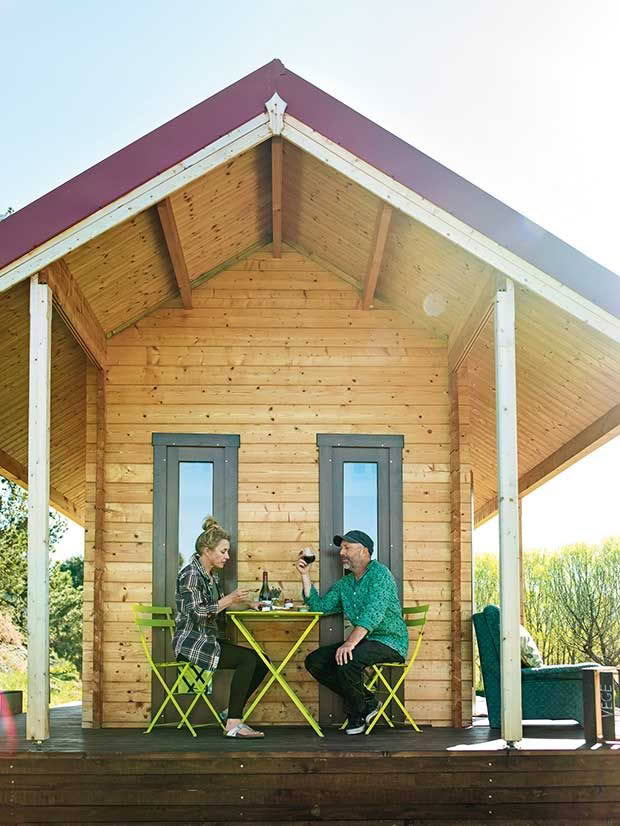
Jeff and Jane mostly put the kitset cabin together themselves — the roof tested the bounds of their marriage — aided by friends carefully selected for their skills, particularly Jeff’s ice hockey mates (he’s also the coach of Dunedin Thunder).
“We chose this one because it’s do-able. You could build it in three days if you knew what you were doing. It’s like Lego; once you’ve done the foundations, you put the baseboards down and it just slots together, with big steel pins in the corners,” Jeff says.
The entire building — bar the roofing but including the ceiling — arrived in three flat packs.
“Then you open it up and go, ‘What on earth do I do now?’” says Jeff. “They come with a general plan but it’s written by people with English as a second language. and yet even if it were written in proper English, I would have messed some things up. But by not getting overwhelmed, and doing one thing after another, it started to materialize.”
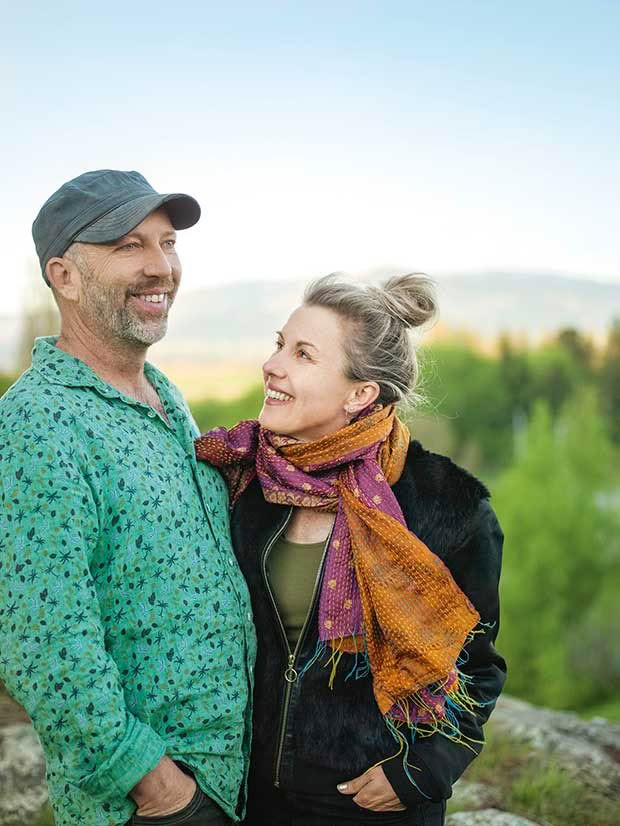
While Jane and Jeff could have bought something for about $14,000, they decided to pay more than twice the amount for the Czech-designed Eurowood cabin.
“We worked on the principle ‘the cheapskate pays twice’,” says Jeff. “This is good-quality spruce, interlocked tongue and groove. We bought the 55-millimetre-thick cabin, rather than the 33-millimetre version, so it’s cosy in winter.”
The best part, as far as both are concerned, is that Jeff didn’t need to cut a single piece of wood, aside from the foundations.
THIS SUMMER WE’LL BE…
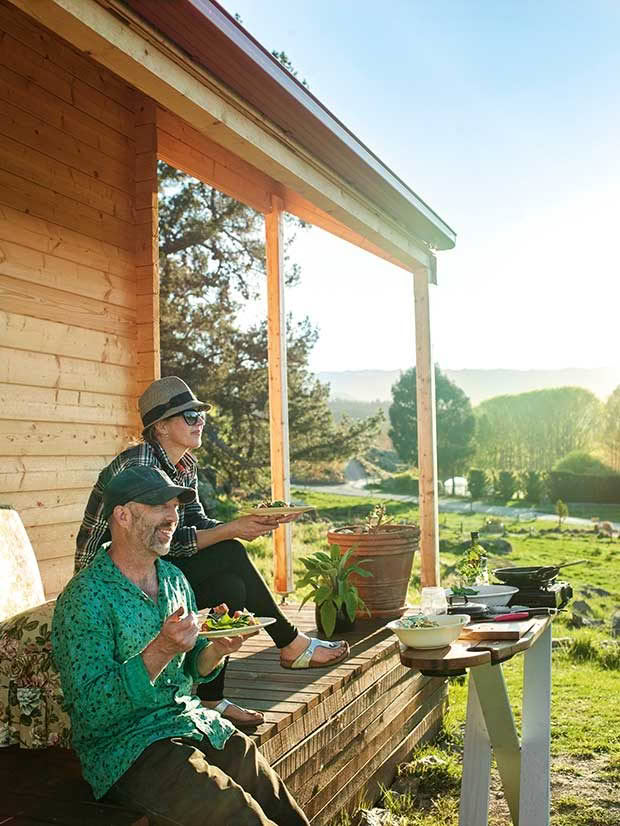
The pair has found settling into Alexandra easy and say they “lucked in” with their neighbours. “They’re so generous, always bringing over produce. And they always know how to fix something if we need help.”
Reading: Most likely Haruki Murakami’s new novel Killing Commendatore (I am a big fan) while Jeff will be reading Bruce Springsteen’s autobiography Born to Run.
Cooking: Whatever’s in season, locally grown, and in Mum’s Bannockburn vegetable patch. We source from the wonderfully abundant Otago Farmer’s Market and, when at the cabin, Rob’s Rural Market in Earnscleugh Road.
Drinking: Kombucha, G&Ts and the occasional glass of the neighbour’s pinot noir rosé.
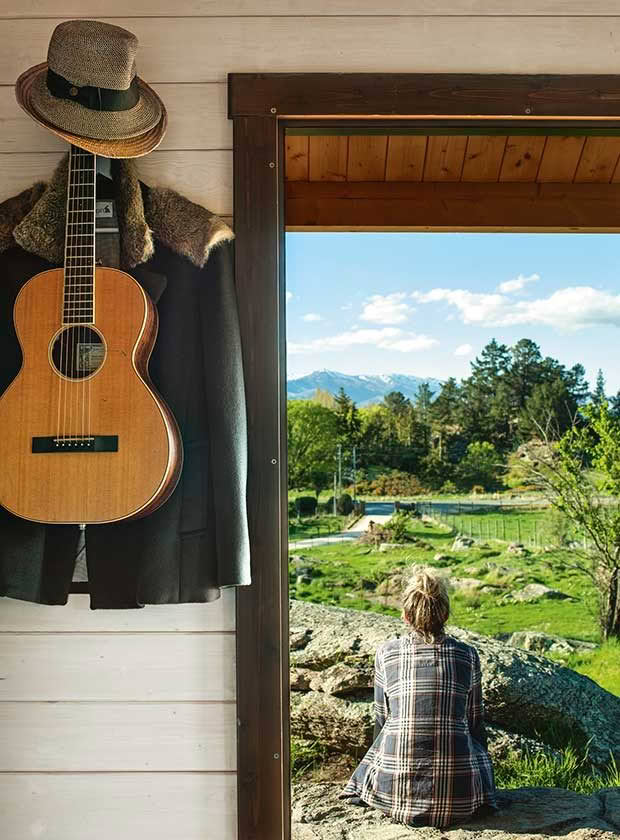
Listening to: The usual bunch of miraculously unscratched CDs lying around the Subaru, which include Bowie, Led Zep, Bruce Cockburn, Crowded House, and believe it or not, ABBA. I get my Queens of the Stone Age and other loud fixes on Spotify. And Jeff will be playing his guitar of course.
Playing games such as: If our friend Susie comes to stay we will insist she brings Cards Against Humanity. Otherwise chess, backgammon, and Scrabble.
Carrying out family traditions: As it will be just Jeff, Angus and me for Christmas in Central this year (everyone else is gathering in the North Island) we will most likely launch our kitsch orange and cream 1970s fibre glass boat and bob around on Lake Dunstan critiquing the water skiers and jet-ski bogans. Classic.
Love this story? Subscribe now!
MORE STORIES YOU MIGHT LIKE
Thinking outside the box in a 60sqm container house (in cherry orchard)
New Zealand-made clothes designed in a high-country sheep station
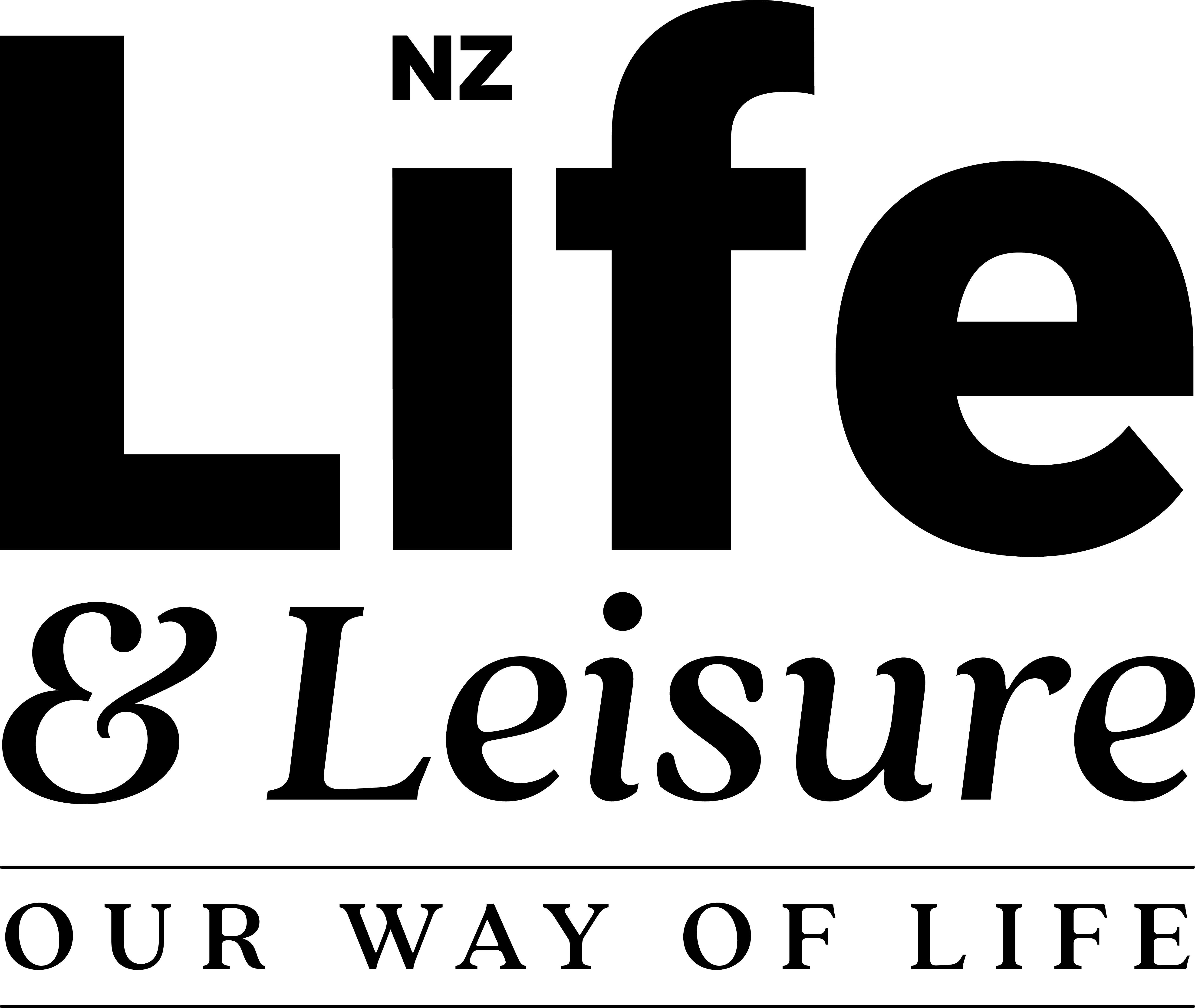 This article first appeared in NZ Life & Leisure Magazine.
This article first appeared in NZ Life & Leisure Magazine.

